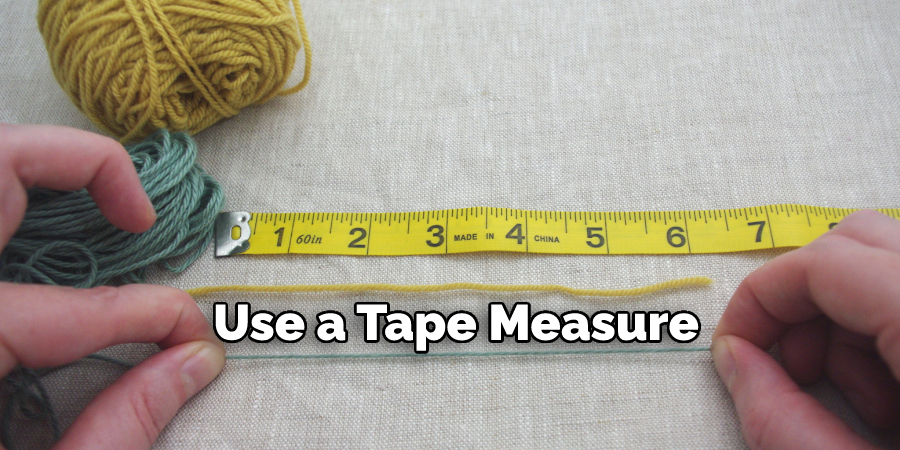Blocking cotton yarn can help you to improve the look and shape of your finished knitted or crochet project. It will also give a more even tension and texture to your work, ensuring that it looks professional and well-made. Blocking is especially helpful when working with intricate stitch patterns, as the pattern stitches will be much easier to see after blocking. Blocking also allows you to adjust the size of a garment, such as blocking out a collar or lapel to make it larger or smaller.

The advantages of blocking cotton yarn include straightening edges, evening out stitches, and giving projects a more finished look. Blocked cotton yarn is also easier to work with when you are sewing or weaving in ends. Additionally, blocking can help you achieve a specific size for your projects, such as a scarf that needs to fit around the neck of the recipient or an afghan that needs to fit over a particular area. In this blog post, You will learn how to block cotton yarn in detail.
Tools and Materials You Will Need
A Bowl of Cold Water:
To block cotton yarn, you will need a bowl of cold water. Make sure the bowl is large enough to accommodate your project and deep enough to cover it completely with water.
Towels:
You will also need towels to absorb excess water from your project. It is recommended to use light-colored towels, so they do not transfer any color onto your work.
Rustproof Pins:
Rustproof pins are essential when blocking cotton yarn, as regular pins can leave rust marks on your project. Choose stainless steel or nickel-plated rustproof pins.
Blocking Mats:
Blocking mats come in a variety of sizes and can be made from foam or cork. They provide a stable surface to pin your project onto while it dries.
Tape Measure:
A tape measure is necessary when blocking cotton yarn, as it will allow you to accurately measure the size and dimensions of your project before and after blocking.
Blocking Wires:
Blocking wires are useful for achieving straight edges on your project. They come in various lengths and thicknesses, depending on the size of your project.
9 Step-by-Step Processes for How to Block Cotton Yarn
Step 1: Inspect Your Yarn
Check for any knots or uneven yarn sections that need to be removed before you start blocking. Pinning blocks, T-pins, tape measure, and a damp cloth are all necessary supplies for properly blocking your cotton yarn.
It is essential to make sure your yarn is clean and free of any stains or dirt before blocking. You can gently hand wash your project if necessary, taking care not to agitate the fibers too much. Allow the yarn to dry completely before beginning the blocking process.
Step 2: Pinning the Yarn
Spread your yarn on a flat surface and use T-pins to secure it. Make sure you use enough pins to block the entire piece, as this will prevent stretching or shifting when blocking. You can also use weights, such as books or small stones, to help keep the yarn in place.
The pins should be placed along the edges of your work, about ½ inch apart. If you are blocking a garment, make sure to pin the sleeves and any other areas that need shaping. The pins should be inserted at a slight angle so they are secure and will not slip out.
Step 3: Measuring and Blocking
Use a tape measure to get an accurate measurement of the yarn. Make sure you measure from end to end, including any knots or uneven cross-sections of yarn. Once you have the measurements, use pins to block the yarn into place and ensure that the measurements are accurate. If the project is a specific shape, such as a sweater or shawl, make sure to pin it into that shape while measuring.

You can also use blocking wires to help achieve straight edges if needed. These are especially helpful when working on lace projects.
Step 4: Secure Pins with a Damp Cloth
Once the pins have been placed and the yarn is blocked, use a damp cloth to secure them in place. The moisture will help keep the pins from slipping while you work on other projects. Allow your yarn to dry before using it. The drying process can take a few hours to overnight, depending on the thickness of your yarn.
You can also use a steamer or spray bottle to dampen the yarn if needed. Just make sure not to oversaturate it as this can lead to stretching or distortion of your project.
Step 5: Use Steam
If you are in a hurry, you can use steam to help speed up the drying process. Hold an iron or steamer close to the yarn without touching it, and move it back and forth over the blocked area. Make sure not to leave the iron or steamer in one place for too long, as this can cause damage to your project.
There are also blocking kits available that include a steam iron specifically designed for use in blocking. These can be useful if you plan to block frequently.
Step 6: Removing the Pins
Once your yarn is dry, you can remove the pins carefully. Take care not to pull on the yarn when removing them, as this could distort its shape. If you find that the yarn has shifted when removing pins, use your fingers to gently adjust it back into place.
You may also find that the edges of the yarn have curled slightly. This is normal and can be fixed by gently stretching them back into shape with your fingers.
Step 7: Inspect Your Work
Check for any areas that may need additional blocking or adjustments. If you notice any unevenness, you can dampen those areas and re-block them. Make sure to let the yarn dry completely before handling it again. Otherwise, it may lose its shape again.
You can also use this time to weave in any remaining ends or add any embellishments, such as fringe.
Step 8: Air Dry
After removing the pins, let your project air dry completely before handling it. This will allow the yarn to set in its new shape and prevent it from losing its blocked form. You can lay it flat on a towel or drying rack to speed up the process.
It is essential to make sure your project is fully dry before using it, as any residual moisture can cause mold or mildew to form. You can also use a fan to help circulate air around your project and speed up the drying process.
Step 9: Enjoy Your Finished Project!
Once your project is fully dry, you can enjoy the finished results of your blocked cotton yarn. You should notice a significant difference in the look and feel of your work, with more even stitches and a professional finish. Blocking can also help to improve the drape and wearability of your project, making it more comfortable to wear or use.
Remember to always follow the instructions for your specific yarn and project when blocking. With these step-by-step processes, you can confidently block your cotton yarn and achieve beautiful results every time!
With these simple steps, you can easily block your cotton yarn and ensure that it is the perfect size for any project. Blocking also helps preserve your yarn’s shape and texture so that it remains in its best condition.
Safety Tips for How to Block Cotton Yarn
Make sure the board you are blocking your cotton yarn on is clean and free of any debris or dirt which could damage the yarn during blocking.
Use a special spray bottle with a mild detergent solution to dampen the cotton yarn before beginning the blocking process – this will help it retain its shape while being blocked.
Use a quality blocking surface such as foam mats, thick felt, or foam board to help ensure the expected shape of your blocked cotton yarn is achieved.
When pinning the yarn into place during blocking, use rust-proof pins and ensure they’re secure enough that they won’t move while being blocked.
If you are wet-blocking your cotton yarn, ensure that the water is lukewarm to prevent the shrinking or stretching of the yarn.
Block your cotton yarn in sections, and avoid blocking an entire piece or swatch of yarn at one time, as this may cause uneven results.
Allow the cotton yarn to dry thoroughly before you remove it from the blocking board or surface.

Finally, store your blocked cotton yarn in airtight containers to keep it safe and clean from dust and dirt. Following these safety tips when blocking your cotton yarn will help ensure a successful outcome each time.
How Much Tension Should You Apply When Blocking the Yarn?
When blocking cotton yarn, it is important to apply moderate tension when stretching the yarn. Too much tension can cause the fibers in the yarn to break, while insufficient tension will not adequately remove all wrinkles and kinks from the yarn. Hold your hand-knitted piece up to the light to determine how much tension you should apply when blocking cotton yarn.
If you can see through the fabric, then it is not stretched enough and needs more tension. However, if the fabric becomes opaque and starts to distort with too much tension, then it is time to reduce the amount of tension used for blocking. It is best to practice a few times before you attempt to block your finished project. This will help you become familiar with the amount of tension that should be applied to the yarn.
Once you are satisfied with the amount of tension used for blocking, it is important to ensure your pins are placed evenly across the surface of your piece. Pins that are too close together can cause an uneven distribution of tension, leading to puckering in the fabric. It is also important to ensure the pins are straight and perpendicular to the surface of your fabric. This will ensure that your piece is blocked evenly and consistently.
How Long Does It Take to Block Cotton Yarn?
Blocking cotton yarn can take anywhere from several minutes to several days. How long it takes depends on your project size and how much blocking you need to do for it to look its best. Larger projects with more intricate stitch patterns will naturally take longer than smaller ones that use basic stockinette stitches. Also, the type of blocking you opt for will affect the amount of time it takes. Wet blocking is more labor-intensive and can take several days, whereas steam blocking can be done relatively quickly.

Once your project is finished, it’s best to wait until all pieces are completely dry before removing any pins or wires used to block them. This ensures that the yarn retains its shape and looks just as you’d like it to. If you’re using cotton yarn for a project, it’s always recommended that you block it before wearing or displaying the item. This can help relax any stiffness in the fabric and give your piece a polished, professional finish.
How Do You Prevent the Yarn From Shrinking or Becoming Misshapen During Blocking?
To prevent the yarn from shrinking or becoming misshapen during blocking, it’s important to use lukewarm water and mild soap to soak the yarn before blocking. Make sure that you don’t use hot water, as this can cause the cotton fibers to shrink.
After soaking, gently squeeze out excess water with your hands and lay the yarn out on a flat, dry surface. You can use a towel as well to help hold it in place.
Use pins or clips to hold the yarn in place while it dries. Make sure not to stretch the yarn too much when pinning so that you don’t distort its shape.
Allow the yarn to dry completely before removing it from the surface and unpinning it. This will help it keep its shape even after blocking.
Finally, use a steamer or iron on low heat to press out any wrinkles in the yarn if necessary. Make sure that you don’t apply too much pressure or heat to the yarn, as this can cause it to become misshapen.

Following these steps will help ensure that your cotton yarn is properly blocked and retains its shape for a long time. With proper care and maintenance, you can keep your projects looking great.
How Can You Remove Any Wrinkles or Creases That May Have Formed During Blocking?
Begin by dampening the area around the cotton yarn with a spray bottle filled with water or by using a damp cloth to moisten the yarn lightly.
Place a dry towel over your work surface, then place the cotton yarn on top of it.
Using either an iron on low heat or a steamer, gently press or steam the yarn in sections. Make sure not to leave the heat source on any one section for too long, as this can damage the yarn fibers.

After each section has been lightly pressed or steamed, move on to the next area and repeat until all of the wrinkles have been removed.
Once the cotton yarn has been completely free of any wrinkles or creases, allow it to dry before using or storing it.
Following these steps can help ensure that your cotton yarn remains in good condition and is ready for whatever project you have in mind.
You Can Check It Out To Crochet Pineapple Doily
Frequently Asked Questions:
Q: Can I Block Cotton Yarn Using Just Water and No Soap?
A: Yes, you can use just water to block your cotton yarn if you prefer. However, using a mild soap or detergent can help remove any dirt or oils that may have accumulated on the yarn during knitting. You can also add a small amount of white vinegar to the water to help soften the yarn and remove any odors.
Q: Can I Steam Block My Cotton Yarn Instead of Wet Blocking?
A: Yes, steam blocking is a great alternative to wet blocking for cotton yarn. It is quicker and easier, but be sure to use caution when using an iron or steamer on your project as too much heat can damage the yarn fibers.
Q: Can I Reuse the Same Pins or Wires for Blocking Multiple Projects?
A: While it is possible to reuse the same pins or wires for multiple projects, it is recommended to use new ones if possible. Over time, pins and wires can become dull and may not hold the yarn as securely, leading to uneven blocking results. It is also important to make sure your pins and wires are clean before using them for a new project, as any dirt or residue from previous projects can transfer onto the new yarn.
Conclusion
In conclusion, blocking cotton yarn is a great way to give your final project an even and professional look. You can achieve great results with minimal effort by following the basic steps of wetting, pinning, and steaming.
Blocking also helps to even out tension inconsistencies that may have occurred during the knitting or crocheting process. Anyone can successfully block and finish their cotton yarn projects with practice and patience. I hope this article has been beneficial for learning how to block cotton yarn. Make Sure the precautionary measures are followed chronologically.
You Can Check It Out to Knit a Bow

